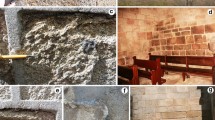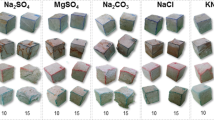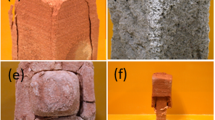Abstract
Physical and chemical weathering were studied as separate processes in the past. Recent research, however, shows that most processes are physicochemical in nature. The rates at which calcite and silica weather by dissolution are dependent on the regional and local climatic environment. The weathering of silicate rocks leaves discolored margins and rinds, a function of the rocks' permeability and of the climatic parameters. Salt action, the greatest disruptive factor, is complex and not yet fully understood in all its phases, but some of the causes of disruption are crystallization pressure, hydration pressure, and hygroscopic attraction of excess moisture.
The decay of marble is complex, an interaction between disolution, crack-corrosion, and expansion-contraction cycies triggered by the release of residual stresses. Thin spalls of granites commonly found near the street level of buildings are generally caused by a combination of stress relief and salt action. To study and determine weathering rates of a variety of commercial stones, the National Bureau of Standards erected a Stone Exposure Test Wall in 1948. Of the many types of stone represented, only a few fossiliferous limestones permit a valid measurement of surface reduction in a polluted urban environment.
Similar content being viewed by others
References Cites
Arnold, A., 1981, Nature and reactions of saline minerals in walls: The Conservation of Stone II, Bologna, October 27–30, 1981, p. 13–23.
Arnold, A., 1982, Rising damp and saline minerals: Fourth International Congress on the Deterioration and Preservation of Stone Objects, July 7–9, Louisville, KY, p. 11–28.
Černohouc, J., and Šolc, I., 1966, Use of sandstone vances and weathered basaltic crusts in absolute chronology: Nature, v. 212 (5064), p. 807–807.
Fritz, S. J., and Ragland, P. C., 1980, Weathering rinds developed on plutonic igneous rocks in the North Carolina Piedmont: Am. J. Sci. v. 280, p. 546–559.
Kessler, D. W., and Anderson, R. E., 1951, Stone exposure test wall: Nat. Bur. Stand., Building Materials and Structures Rept. 125, 41 p.
Likens, G. E., 1976, Acid precipitation: Chem. Eng. News, November 22, 1976, p. 29–44.
Puehringer, J., 1983, Salt disintegration: salt migration and degradation by salt—a hypothesis: Swedish Council for Building Research, D-15, Stockholm, 159 p.
Vos, B., Tammes, E., 1969, Moisture and moisture transfer in porous materials: Inst. TNO For Building Materials and Building Structures, Report No. B 1-69-96.
Whalley, W. B., Douglas, G. R., McGreevey, J. P., 1982, Crack propagation and associated weathering in igneous rocks. Z. Geomorphol. N.F., v. 26, no. 1, p. 33–54.
Winkler, E. M., Singer, P. C., 1972, Crystallization pressure of salts of stone and concrete. Geol. Soc. Amer. Bull, v. 83, no. 11, p. 3509–3514.
Winkler, E. M., Wilhelm, E. J., 1970, Saltburst by hydration pressures in architectural stone in urban atmospheres: Geol. Soc. Am. Bull. v. 81, no. 2, p. 567–572.
Winkler, E. M., 1981. The effect of residual stresses in stone: Conservation of Stone 11., Intern. Symp. Bologna, Oct. 27-30, p. 3–11
Winkler, E. M., 1982, Decay of stone monuments and buildings: The role of acid rain: Technology and Conservation, Spring 1982, p. 32–36.
Author information
Authors and Affiliations
Rights and permissions
About this article
Cite this article
Winkler, E.M. Weathering and weathering rates of natural stone. Environ. Geol. Water Sci 9, 85–92 (1987). https://doi.org/10.1007/BF02449939
Issue Date:
DOI: https://doi.org/10.1007/BF02449939




